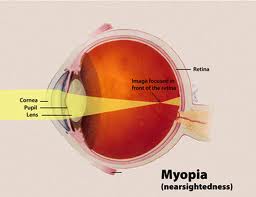Refractive errors (more commonly known as nearsightedness, farsightedness, astigmatism and presbyopia) are the most common vision problems occurring when the shape of the eye prevents light from focusing directly on the retina. The length of the eyeball (either longer or shorter), changes in the shape of the cornea, or aging of the lens can cause refractive errors. Most people have one or more of these conditions.
Different types of refractive errors happen to a specific group. Namely, Presbyopia affects most adults over age 35. Other refractive errors can affect both children and adults. Individuals that have parents with certain refractive errors may be more likely to get one or more refractive errors.
There are four main types of refractive errors:
Nearsightedness is a condition where objects up close appear clearly, while objects far away appear blurry. Consequently, close objects look clear but distant objects appear blurred. Myopia, or nearsightedness, is normally inherited and is often discovered in children when they are between the ages 8 and 12 years old.
Farsightedness is a common type of refractive error where distant objects may be seen more clearly than objects that are near. However, people experience hyperopia differently. Some people may not notice any problems with their vision, especially when they are young. For people with significant hyperopia, vision can be blurry for objects at any distance, near or far.
Astigmatism is a condition in which the eye does not focus light evenly onto the retina, the light-sensitive tissue at the back of the eye. This can cause images to appear blurry and stretched out.
Presbyopia is an age-related condition in which the ability to focus up close becomes more difficult. As the eye ages, the lens can no longer change shape enough to allow the eye to focus close objects clearly.
How to treat refractive errors?
The most common method of correcting refractive errors is using eyeglasses. They work by focusing light rays on the retina, compensating for the shape of your eye. Refractive surgery is also an option to correct or improve your vision. This surgical procedure is used to adjust your eye’s focusing ability by reshaping the cornea, or front surface of your eye. All of your options can be discussed with your eye doctor.

